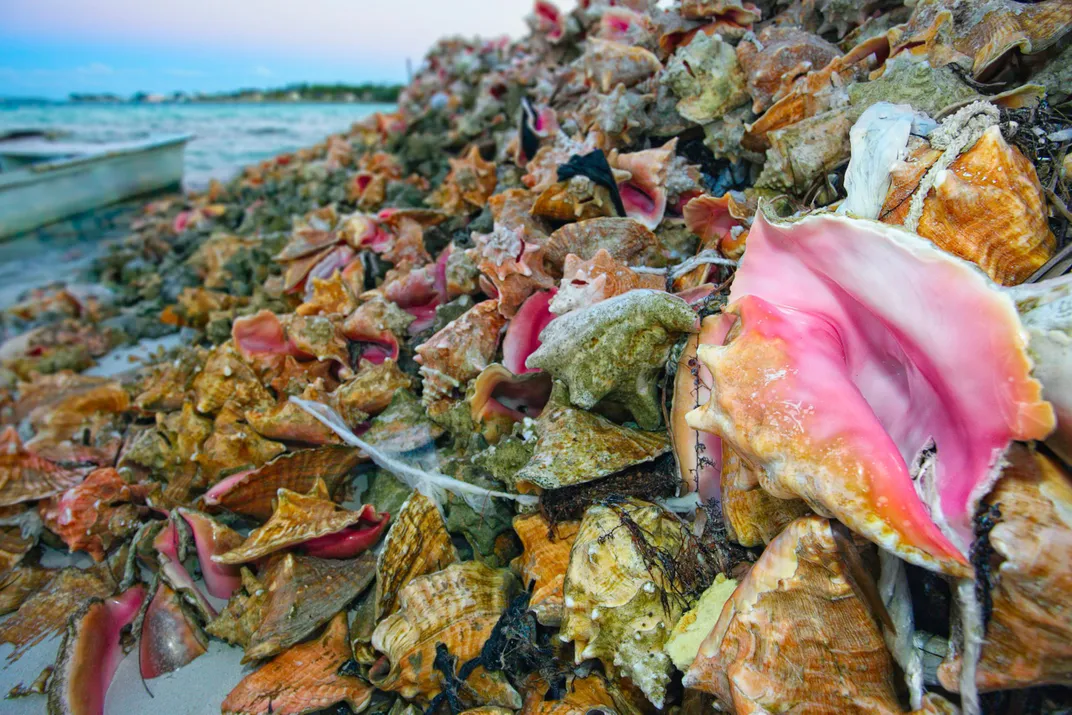The Bahamas’ Conchs Have Undergone ‘Serial Depletion’
But it’s not too late to save them
/https://tf-cmsv2-smithsonianmag-media.s3.amazonaws.com/filer/31/79/31790f69-e90c-40e2-a8f3-7f7d09ddaab4/gettyimages-948060376.jpg)
Queen conchs seem to be everywhere in the Bahamas. The molluscs’ meat is served in salads and other local dishes, their pinky-orange shells are sold to tourists, and festivals celebrate conchs’ importance to the history of the island nation. But the prevalence of conchs in the Bahamas’ culture and economy has come at a sobering cost: As Jenny Staletovich reports for the Miami Herald, a new study has found that the country’s conchs have undergone “serial depletion.”
The study, published in the journal Reviews in Fisheries Science and Aquaculture, analyzed surveys of conchs in the Bahamas taken between 2009 and 2017. Collectively, the surveys encompassed 42 sites and one million square meters. Researchers then compared the data to historic surveys dating back to 1987.
They were specifically looking to find out how overfishing has impacted conch populations. According to National Geographic’s Sarah Gibbens, the Bahamas “has some of the laxest conch fishing regulations in the Caribbean.” The country has implemented a number of protective measures—like export quotas and designated protected marine areas—but officials lack the funding and support necessary to enforce these rules. In 2015, Gibbens reports, 400 metric tons of conchs were fished in the Bahamas, and about half of the catch was exported.
Intense fishing, the authors of the new study found, has indeed had a dire impact on the Bahamas’ conchs. The number of adult conchs have fallen in direct proportion to increased fishing pressure, and the average age of conch populations is getting younger. In some of the seagrass meadows where conchs dwell, just a small number of young critters remain.

Only adult conchs can be legally fished in the Bahamas, in order to give juveniles a chance to grow and reproduce. But the snails have been so over overfished that “[d]ensities of legal-to-harvest queen conch are now far below the well-established minimum threshold for reproductive success,” the study authors found. They add that unless drastic measures are taken to save the animals, the Bahamas could lose its conch fishery within 10 to 15 years.
As is the case with all threatened species, conchs play an important role in their ecosystem. The snails keep seagrass beds clean by chomping on dead plant matter, and they are also a substantial food source for predators like sharks and turtles. Their depletion could also have a dire impact on human residents of the Bahamas: conchs are important to Bahamian culture, and sustain livelihoods on the islands. “If the conch fishery collapses, it could put more than 9,000 Bahamian fishers—two percent of the country’s small population—out of work,” Gibbens writes.
Fortunately, hope is not lost. “[G]overnment actions can help recover the Bahamian stocks,” says Allan Stoner, lead study author and senior scientist at Community Conch, a non-profit seeks to protect the molluscs.
The researchers put forth a number of suggestions for managing conch fisheries. Ending conch exports is one of them, and the authors also recommend implementing a size limit for legally harvestable conchs. The flared “lips” of conch shells thicken as the animals age, and can thus be an indicator of whether a conch has reached maturity and been able to contribute to the future of population through reproduction. The researchers say shells should reach a thickness of 15 millimeters before the animals are harvested. And to make sure the rules are being followed, fishers should be required to bring the conchs out of the water in their shells, rather than cracking them and scooping out the meat below the water’s surface.
In response to reports about the Bahamas’ conch crisis, agriculture and marine resources minister Michael Pintard said he would be “strongly recommending” these measures and others to save the animals. For now, most of the proposed solutions are relatively moderate. If they don’t work, it may be necessary to stop fishing conchs entirely for a period of five years—a plan that is likely to be met with resistance among Bahamians who rely on the animals for money.
“[I]t will be important to assist displaced fishers in finding other sources of income,” Stoner says.
Though the process might be difficult, it is important for the Bahamas to take action while the country’s conchs can still be saved. As Andrew Kough, study co-author and research biologist at Shedd Aquarium in Chicago, puts it, the new research “paints a grim outlook and demands urgent action before we all lose a beloved snail species and tasty treat.”